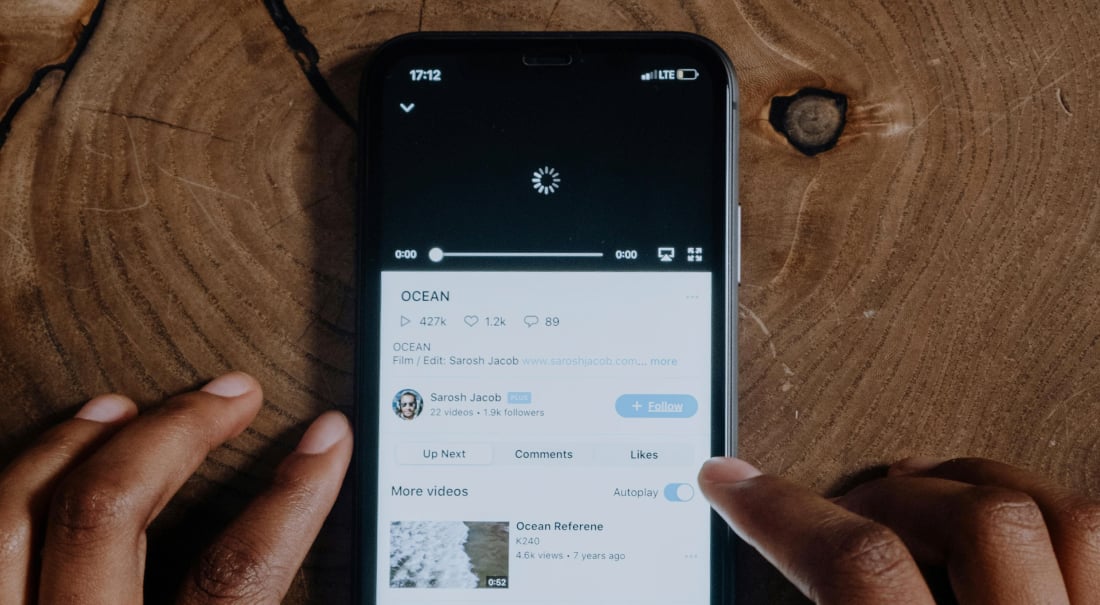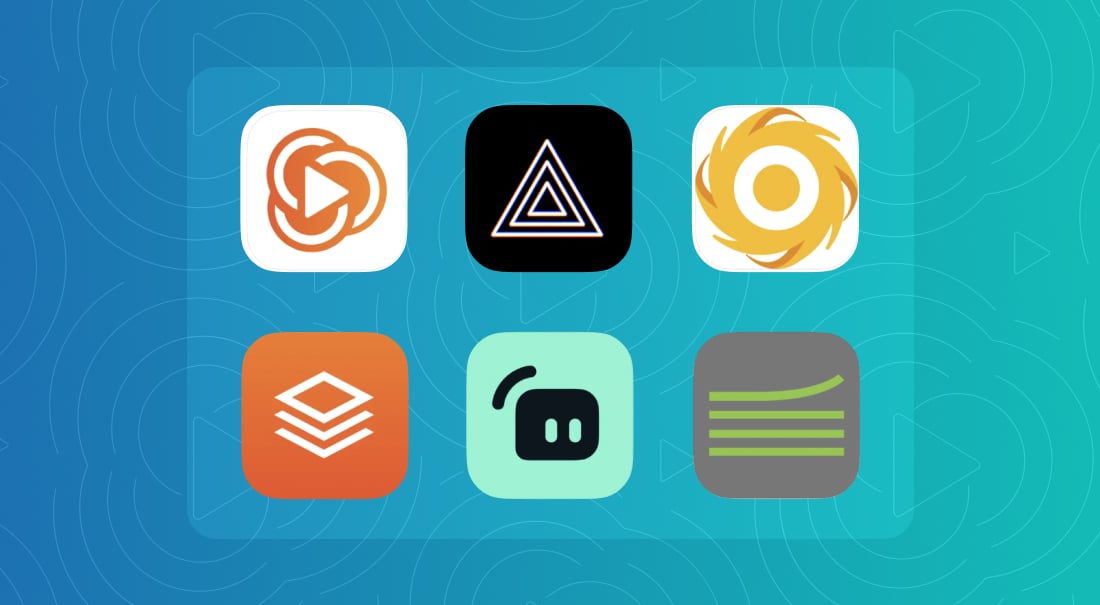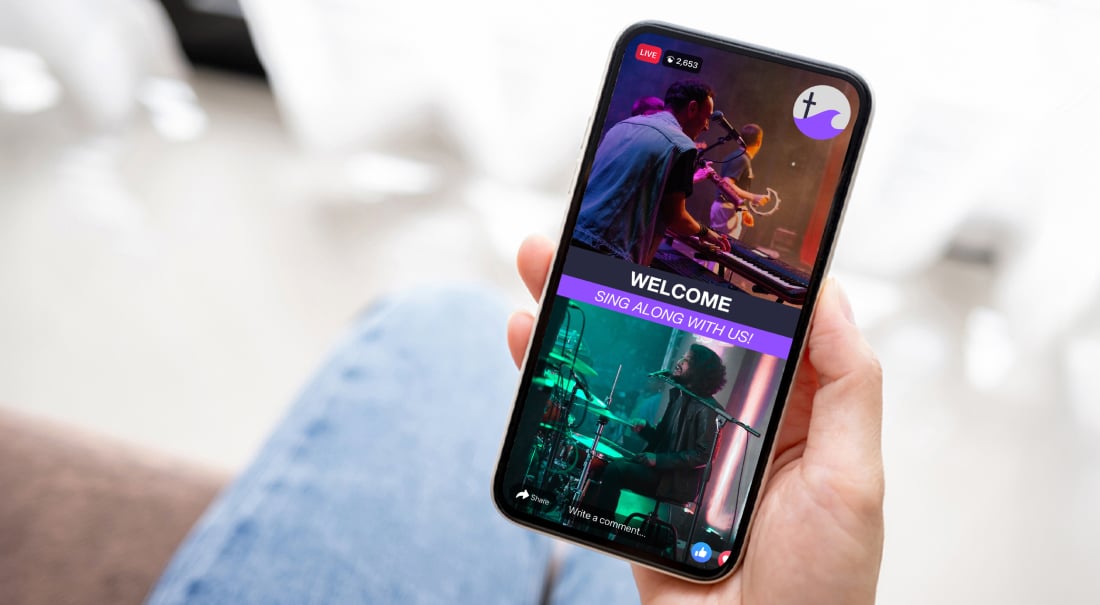
The live streaming industry continues to grow — and so do the number of live streaming apps. With so many choices out there, how do you choose the best live streaming app? We’ve sorted through the options and compiled a definitive list of the best live streaming apps in 2025.
What is a live streaming app?
There are a few different kinds of live streaming apps.
Generally, a live streaming app is a platform on which you can watch and share streamed content. Think YouTube Live and Twitch: You can stream natively on these platforms and you can watch other creators stream.
There are also live streaming apps that allow you to embed your content onto your website, or apps that allow you to watch streams but not upload them. These aren’t social platforms, but more like content creation platforms or branded apps for businesses. This category could technically also include video conferencing apps like Zoom or Google Meet.
Additionally, many apps can enhance your live streaming creation. That means apps that help you to create better, more exciting livestreamed content, apps that allow you to reach more people, and so on. These apps typically allow you to stream to platforms like YouTube Live, but via their interface, so that you can have control over the output of the livestream.
These companion apps — that is, apps that make live stream creation possible — are some of the popular types of live streaming apps.
What is Multistreaming?
Once you begin considering live streaming apps, you’ll encounter the term “multistreaming” (or occasionally, “simulcasting”). Multistreaming refers to live streaming to multiple platforms at one time, e.g., YouTube Live and Twitch. Multistreaming is something that can only be done through a live streaming app — you can’t natively stream to multiple platforms without the aid of an app that has multistreaming functionality.
How to choose a live streaming app
Let’s say you’re a new creator looking for a live streaming app. With so many options to consider, how do you choose? Naturally, it depends on your goals, your audience, and your content. For example, if you’re a podcaster hoping to grow your audience, you might not have the same goals as a boutique hoping to sell products and earn money with their live videos.
Here’s what to consider when choosing a live streaming app:
-
User experience: Is the app intuitive? You don’t want to spend more time figuring out the tech than engaging with your viewers. Choose a platform that’s straightforward to navigate.
-
Customizability: Your brand’s personality should shine through every livestream. Look for an app that lets you tweak colors, add logos, or make your stream look polished.
-
Scalability: Whether you’re streaming to a small, intimate group or an international audience of thousands, the app you choose should be able to grow with you. Think about your future needs and whether the app can handle them.
-
Engagement tools: Livestreaming is all about interacting with your audience and creating genuine human connections. So, look for features like live chat, polls, and Q&A—the more ways you can connect, the better.
-
Integrations with other tools: The best livestreaming apps work seamlessly with the other platforms. Whether you want to multistream across social media sites or sell products through your ecommerce website, integrations give you room to grow and expand.
-
Analytics: Understanding how your streams are performing helps you make smarter decisions moving forward. So, look for live streaming apps that give you insights into viewer behavior, engagement rates, and performance metrics.
Keep these tips in mind as we compare the features and functionalities of 21 of the best live streaming apps in 2025.
Best native live streaming apps in 2025
YouTube Live
YouTube is, without a doubt, one of the most popular video platforms ever, with well over two and a half billion users worldwide. Anyone can sign up for a YouTube account, and you can livestream (or upload recorded videos) from a computer or a mobile device. There are innumerable categories of video content on YouTube, so it’s a great platform for almost any kind of content creator.
YouTube is considered the second-largest search engine in the world, so there's a clear opportunity to reach the people who truly care about your content. However, the majority of the video content on YouTube is video on demand (VOD), not livestreams, so even though YouTube is a preeminent platform with tons of benefits, there are still some downsides for streamers.
Pros
-
In-depth analytics and reporting
-
Massive audience and robust search algorithm
-
Integration with Google means that YouTube videos show up in Google search results
-
YouTube Partner Program offers built-in monetization tools like Super Chat, Super Stickers, and channel memberships
-
Capability to share long-form and short-form videos on the same platform
-
Ability to archive previous streams and videos on demand
Cons
-
Live content isn't the platform's priority
-
YouTube controls who advertises on your content
-
It can be hard for new creators without an established audience to get noticed on such a huge platform
-
Membership in the YouTube Partner Program (i.e., monetization) requires 1,000 subscribers and 4,000 hours of watch time
-
Monetization features come with hefty revenue shares — e.g. YouTube takes 30% of your Channel Membership money.
Uses
-
News
-
Gaming
-
Sports
-
Live vlogs
-
Interviews
-
Product announcements
-
Tutorials
-
Webinars
-
Everything in between
Facebook Live
Like YouTube, Facebook is a huge platform with plenty of opportunities for live streaming. Facebook is the most popular social media platform with over three billion monthly users (as of 2025). Facebook also offers the opportunity to share longer content and short-form content on the same platform with their Reels and Stories features. Creators can stream from desktop or mobile to a professional page, personal profile, or Facebook group, which supports audience growth and cultivation.
Pros
-
Prioritized live content: Followers are notified when you go live
-
Built-in chat moderation settings
-
Real-time livestream performance analytics
-
Monetization from in-stream ads
Cons
-
Maximum livestream length of 8 hours
-
No content indexing, meaning that Facebook Live videos don’t appear in search engine results
-
Complicated interface
-
Limited community engagement tools
-
Streaming in HD is restricted to members of Level Up (Facebook’s gaming creator program) and managed partners
Uses
-
Gaming
-
Live shopping
-
Live events and performances
-
Industry updates
-
Live Q and As
-
Product announcements
LinkedIn Live
LinkedIn is a unique social media platform. It’s been around for two decades and has always focused on business professionals. There are significantly fewer LinkedIn users than there are YouTube and Facebook users … but the platform is used by millions daily to network, find jobs, and engage with industry thought leaders. LinkedIn also offers four premium pricing tiers.
Pros
-
LinkedIn Live offers a unique opportunity to share content relevant to a particular industry or niche
-
Streams can be directed to LinkedIn profiles, Pages, or Events
-
LinkedIn Lives are public and recorded by default — after a stream ends, the recording stays on your LinkedIn profile or Page
-
Robust analytics
Cons
-
LinkedIn Live access is restricted to members and Pages with more than 150 followers, among other criteria
-
LinkedIn doesn't support streaming natively, so creators need to use a third-party broadcast tool to create a LinkedIn Live.
-
The maximum livestream duration is four hours
-
Content generally relates to industry news and professional interests, so the platform won’t support every type of creator
-
Limited livestream viewership compared to other platforms
Uses
-
Company announcements
-
Recruitment
-
Workshops
-
Industry updates
-
Live events
-
Q&As
Instagram Live
Alongside Facebook, Instagram is a Meta-owned social media platform with a huge number of members: more than two billion monthly active users. An estimated 100 million people watch Instagram Live content every day. Instagram began as a mobile app, and though many of its features are now available on desktop, some (including live streaming) remain mobile-only.
Pros
-
Platform prioritizes live video and takes steps to notify potential viewers: Followers are notified when live streams begin; live videos appear in the super-visible Stories section; and profile icon UI adjusts to indicate when a live stream is in progress
-
Past live streams stay in a profile’s Stories section for 24 hours
-
Instagram Live allows you to invite guests or collaborators to join your stream
-
Because Instagram is owned by Meta, it’s simple to crosspost streams on Facebook Live
Cons
-
The maximum livestream duration is four hours
-
Live streaming is only possible on the mobile app
-
Video quality is dependent on your wireless connection and mobile phone used
-
Livestream monetization (via Badges) is only available for creators with over 10,000 followers
Uses
-
Vlogs
-
Live events
-
News coverage
-
Q&As
-
Product reviews
-
Casual chats
Twitch
Twitch has been around for over a decade, and unlike every other live streaming app we’ve mentioned so far, Twitch is fully dedicated to streaming. There are about seven million active streamers on Twitch, and tens of millions of hours of content are streamed each month. While there are plenty of different kinds of content on Twitch, it’s primarily focused on gaming streams, and many of its creator tools are geared toward gamers.
Pros
-
Popular, established platform purely for live streaming
-
Strong monetization potential, including subscription tiers and unique donation features
-
Community-building tools make Twitch one of the easiest platforms on which to grow your audience
-
Large dedicated support team
-
Powerful channel analytics tools
Cons
-
More narrow audience content interests than other platforms
-
Monetization options are restricted to Twitch Affiliates and Partners, which have some barriers to entry
-
Twitch Affiliates and Partners cannot multistream Twitch content to other platforms under their Terms of Service
-
Strict rules for streaming content and accounts can get banned without warning
-
Unbalanced gender distribution: While most social platforms have a base of around 50% of users identifying as men and 50% of users identifying as women, Twitch is drastically different, with roughly 80% of users identifying as men and 20% of users identifying as women
Uses
-
Gaming/eSports
-
Tutorials
-
Tech events
-
Live vlogs
Kick
Kick is the new kid on the block in the live streaming space founded in late 2022. Created as a competitor to Twitch, it’s best known for being backed by the online casino stake.com and for its comparably low revenue split of 95% of earnings given to the streamer and 5% to the platform. Kick has made headlines by signing well-known streamers such as xQc to lucrative partner deals. Like Twitch, Kick’s primary focus is on gaming and IRL streams.
Pros
-
Popular, up-and-coming platform purely for live streaming
-
Generous 95-5% revenue split between creator and platform
-
Looser TOS restrictions when compared to platforms like Twitch
Cons
-
More narrow audience content interests compared to other platforms
-
Monetization options are restricted to Kick Affiliates, which have some barriers to entry
-
Kick being backed by a gambling company can be considered an ethical dilemma for some
Uses
-
Gaming/eSports
-
IRL/Just Chatting
-
Music
-
Tutorials
-
Tech events
TikTok
TikTok exploded onto the scene in 2018 with its emphasis on short videos, usually set to popular music or sound clips. TikTok is especially popular among younger audiences and now has over 1.6 billion active monthly users. Many other social platforms, like YouTube, Facebook, and Instagram, have attempted to capitalize on TikTok’s popularity by adding the ability to create and share short, vertical-only videos.
Pros
-
Collaborative tools allow streamers to invite other content creators to join their videos
-
The option of sharing standard short-form videos on the same platform supports new creators in growing their audience
-
Options for monetization, including the platform’s Creator Rewards Program
Cons
-
Lack of moderation can result in low-quality content on the platform
-
Minimum of 1,000 followers to use TikTok Live
Uses
-
Vlogs
-
Live events
-
Q&As
-
Product reviews
Vimeo
Vimeo is a platform that supports video hosting and sharing. Its primary feature is a video player embed, plus basic video creation tools and templates. At higher subscription tiers, users can unlock features like live streaming, virtual event and webinar tools, and more. Vimeo is typically used by filmmakers and large companies.
Pros
-
High-quality 4K video upload and playback
-
Ability to enable private and secure live streams
-
No ads displayed on your content
Cons
-
Live streaming and multistreaming are only available to customers on the highest-cost plans
-
Limited viewer base on the Vimeo platform
Uses
-
Demonstrations and classes
-
Subscriptions
-
Filmmaking
-
Live events
-
Q&As
-
Product reviews
-
Tutorials
-
Just about anything
Best 3rd-party desktop live streaming apps
OBS Studio
OBS (Open Broadcasting Software) is a free, open-source software for video recording and streaming. It’s a desktop app, available on Windows, macOS, and Linux. OBS users can capture video and audio from sources like cameras, microphones, and computer screens.
Pros
-
Free, open-source streaming software
-
Quality encoding for high-quality video
-
A large community of users providing support
Cons
-
High CPU utilization can result in degraded performance without a powerful computer
-
Basic UI with limited customization & preset features
-
Frequent updates can cause delays
vMix
vMix is a Windows-compatible desktop software for video mixing and switching. With vMix, users can produce live streams with multiple camera angles, video and audio files, and other media sources. In addition to streaming, users can also record videos and edit them in post-production. vMix is aimed at professional video producers, including broadcast television, event video production, and houses of worship.
Pros
-
High-quality video with support for 4k camera inputs
-
Variety of features, including sets and overlays, graphics templates, scoreboards, and more
-
Compatible with some external video switchers
Cons
-
High CPU utilization can result in degraded software performance on less powerful computers
-
Incompatible with macOS
-
The multicamera feature doesn’t support mobile inputs
Wirecast
Wirecast is another desktop software & live streaming and video production service. Wirecast allows for high-quality multicamera live video productions, as well as audience engagement, collaboration with remote guests, dynamic graphics overlays, and more.
Pros
-
Unlimited live camera inputs
-
Built-in animated graphics
-
Support for Windows and macOS
-
Built-in multistreaming capabilities
Cons
-
High CPU utilization can result in degraded software performance on less powerful computers
-
Multicamera feature does not support mobile inputs
-
Steep learning curve
Streamlabs
Streamlabs consists of a suite of tools for live content creators. The free desktop app offers customizable live stream overlays, and alerts for new followers, subscribers, donations, and more. Streamlabs is most commonly used for streaming video games. It’s available for macOS and Windows and offers solutions for mobile streaming and streaming to Twitch from a console. It is free to use, with additional features available through optional paid upgrades.
Pros
-
Limited free version
-
Graphics and layout templates
-
Widgets for monetization
-
The tips feature allows for real-time donations
Cons
-
Very limited multicamera and remote guest capabilities
-
The desktop app can strain CPU resources
-
Limited multistreaming destinations
Best browser-based livestream applications
Streamyard
StreamYard is a browser-based live streaming app offering popular features like collaborating with remote guests, screen recording, custom branding, and real-time audience interaction through live chat. StreamYard also allows for multistreaming to a limited number of destinations, including Custom RTMP. It has a free version with a StreamYard watermark, or users can pay for additional features.
Pros
-
A basic free version is available
-
Limited built-in multistreaming functionality
-
Four pricing tiers for individuals or businesses
-
Easy-to-use interface
Cons
-
No multicamera capabilities
-
Browser-based only
-
Limited customization options for branding, graphics, and layouts
Restream
Restream is a multistreaming platform designed to allow creators to live broadcast video content to multiple platforms at once. Restream also offers a suite of live video production tools, like remote guest capabilities, custom branding, engagement tools, and more.
Pros
-
Limited free version available
-
Built-in studio software for custom graphics
-
Remote guest capabilities
-
In-depth live streaming analytics
Cons
-
Browser-based only
-
Stream recording storage is time-limited
-
No video upload storage for lower-tier plans
Uscreen
Uscreen is a video membership platform that offers tools for creating a mobile app, community forum, video library, and live events. It also integrates with social media platforms and marketing applications, including Facebook, MailChimp, and Google Analytics.

Pros
-
Community-building oriented toolkit
-
Build a mobile membership app
-
Multicamera and multistreaming capabilities
Cons
-
Expensive: Plans cost $199 per month for Growth and $499 per month for App Essentials
-
Live streaming limitations: Plans include 1 hour of live streaming, then you’ll need to pay for the Live Streaming Add-On package for an additional 10 hours of live streaming
Dacast
Dacast is a browser-based live streaming app with a range of features, including video hosting, live event streaming, and monetization tools. It can also multistream to any RTMP-compatible platform. Dacast offers three pricing plans, each limiting the amount of data you can stream.

Pros
-
Can be used to stream in China
-
Pre, mid, and post-roll advertising features
-
More expensive plans offer unlimited streaming channels
Cons
-
Streaming bandwidth limitations
-
No mobile live streaming app
-
Monthly plans require you to pay three months minimum upfront
Brightcove
Brightcove is a cloud-based video live streaming platform geared for enterprise-level businesses, media companies, and publishers. Brightcove's products include live streaming, audience segmentation, and video hosting.

Pros
-
Highly customizable and designed to integrate with your existing tech stack
-
Extensive range of integrations with third-party platforms, including content management systems (CMSs), analytics tools, marketing automation platforms (MAPs), and Customer Relationship Management Software (CRMs)
-
Strong focus on security and data privacy management
Cons
-
Only suitable for large enterprises
-
Custom pricing plans only
-
Extensive setup with a challenging learning curve
-
Requires a dedicated team of experts to manage and implement
Firework
Firework is a video commerce platform that enables retailers and consumer brands to create shoppable videos and live events. To access the live streaming features, you’ll need to sign up for the Digital Showroom plan, which costs $2,000 per month.

Pros
-
Advanced live selling features
-
AI video creation tools
-
First-party customer data collection
Cons
-
High price point
-
Only suitable for enterprise-level brands
-
Requires a team to implement and manage
Best mobile live streaming applications
Larix Broadcaster
Larix Broadcaster consists of several apps and SDKs (software development kits) for mobile video production. Larix Broadcaster is a trim solution for mobile live streaming with several features, such as landscape and portrait orientation, live rotation support, multicamera video options, audio-only capture mode, and more.
Pros
-
A limited free version is available on iOS and Android
-
The lightweight app allows streaming to most destinations via RTMP from your mobile devices
Cons
-
There’s a steep learning curve for new streamers
-
Clunky UI can cause issues when live streaming
-
Limited video creation and customization features
-
No video storage solution
Mevo
Mevo is an unusual multicamera live streaming solution. Unlike mobile device solutions, Mevo’s multicamera capabilities are restricted to their Mevo cameras. While video switching is controlled via a mobile app, Mevo’s starter pack for multicamera video production includes the purchase of three Mevo cameras — retailing for nearly $1,000.
Pros
-
High-quality Mevo cameras can be connected wirelessly via the Mevo app for multicam live streaming
-
Backed by Logitech, Mevo has a large support team
-
Stream via RTMP or record locally
Cons
-
Creators are limited to the Logitech Mevo family of cameras to use the app
-
Limited to 1080p resolution for live streaming
-
No MicroSD support
-
High price point
Most versatile live streaming app and end-to-end video ecosystem
Switcher Studio
Made with creators and businesses in mind, Switcher Studio is a great solution for live streaming as well as any other video creation and monetization needs. Switcher was designed to make it easy to create multicamera, multisource livestreams, and includes everything you need to create, share, and monetize live and recorded videos.
Pros
-
Streaming and video production:
-
Easy-to-use iOS application with an intuitive interface
-
Mobile multicam solution allows creators to wirelessly connect up to 9 iPhones or iPads to use as wireless cameras
-
Integration with the AccSoon SeeMo device allows you to connect any camera or device with an HDMI output directly to your iOS device and use Switcher Studio
-
Hundreds of customizable in-app graphic templates so you can apply your own branding to your productions
-
Built-in Multistreaming functionality lets you reach up 20 destinations at once
-
Expansive cloud storage for uploaded videos, live stream recordings, clips, graphics, assets, and so on
-
The Switcher Cast desktop app allows users to capture their macOS or Windows screen to include in their production — ideal for gaming or presentations
-
A robust in-app clip editor makes it easy to timestamp special moments, trim your clip, add text, change the aspect ratio, and adjust playback speed before sharing directly to your social media platforms
-
Record locally, stream to major platforms with direct integrations, or use custom RTMP destinations
-
Output to AirPlay, HDMI, or use Switcher as a Webcam with video conferencing software like Zoom, Teams, and Meet
-
-
Hosting and embedding:
-
An embeddable interactive video player (the Switcher Player) turns your website into your own video content channel
-
Host videos and live event recordings without ads or competitor recommendations
-
Create and customize standalone video watch pages
-
Customize your Player to add video information, affiliate links, social profiles, donation platforms (PayPal, Venmo, CashApp), and more
-
-
Monetization:
-
Sell tickets to your live stream events
-
Sell single videos or entire playlists with built-in gated-content monetization tools
-
Earn a steady income by selling subscriptions to your live events and video content
-
Powerful Shopify integration makes live selling and live shopping easy on two platforms: Comment to Cart live shopping for Facebook Live videos, and click to buy directly from Switcher Player embedded on your website
-
Very low monetization fees with no revenue split — keep more of your money with a small $0.99 fee per sale
-
-
Hands-on support:
-
One-on-one setup support to hit the ground running
-
Dedicated, highly responsive support team
-
Extensive resource library
-
Cons
-
No Android app
Uses
-
And more
So what is the best live streaming app in 2025?
We’re obviously partial to Switcher around here … but there’s simply no clear answer for the best live streaming app in 2025. The world of live streaming is constantly evolving, and the range of options is vast, to say the least. From multistreaming–focused browser-based platforms like Restream to mobile-first solutions like Larix Broadcaster — each live streaming app has unique features and functionalities that support different users and use cases.
So, what’s the best live streaming app for you? It depends on your video content goals, your experience level, the platforms you want to reach, the gear you have at your disposal, and the investment you want to put in.
Take your time to compare, contrast, and test the live streaming apps out there until you find one that checks all of your boxes. And, if you want to start by taking Switcher for a spin, sign up for a free two-week trial today.
Subscribe to the blog
Sign up to receive notifications whenever a new blog post is published. You may unsubscribe at any time.

Share
About the Author

Maddie is a writer and curious content marketer with experience in nonprofits, advertising, and tech. As Switcher’s content strategy manager, she’s passionate about connecting with our audience through content that educates and inspires.
All posts by Maddie Tong


